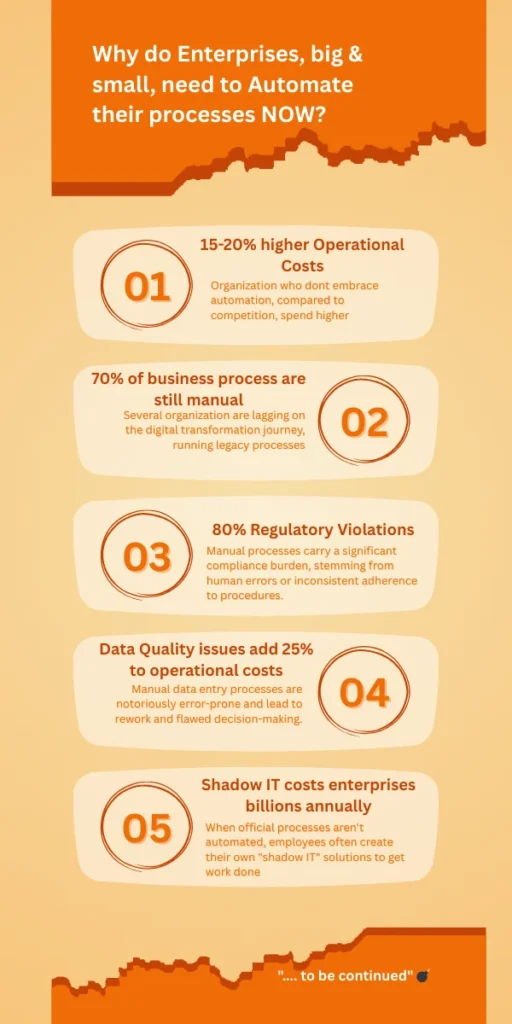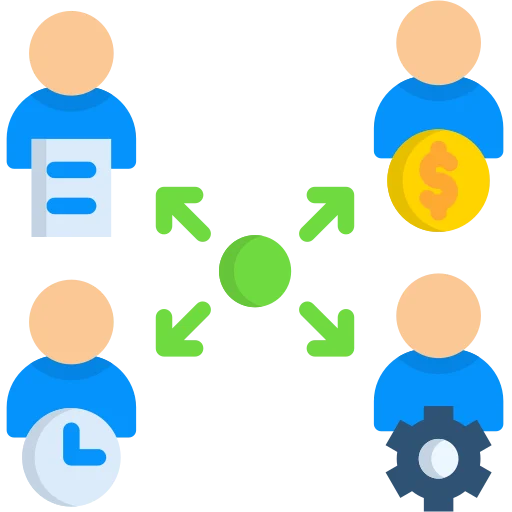Automate Enterprise Workflows. No Code Required
Discover how no-code workflow automation platforms are helping enterprises streamline operations, reduce costs, and transform employee and customer experiences with VorkFlow’s no code automation platform— all without writing a single line of code.

Intro: What is No Code Workflow Automation?
No-code workflow automation lets business users design, deploy, and automate business processes without writing a single line of code. With no-code automation tools like VorkFlow, companies digitize operations faster and reduce dependency on stretched IT resources.
Key Benefits:
- Free up teams to focus on outcomes
- Reduce operational costs
- Speed up process deployment
- Eliminate errors and compliance risk
Why It Matters for Modern Businesses


Wondering ?
Want to learn how VorkFlow solves this for your org? Book a free 30-min assessment.
Top Use Cases by Industry

EDUCATION
80% faster processing of financial aid applications

CROSS FUNCTIONAL OPS
HR, GTM, Finance, Procurement
$8.7M in annual savings through reduced
processing costs

Thinking of a Business Problem ?
Read our Blog that dwells into specific use cases, and how VorkFlow has solved it. Schedule a call with us, to see how VorkFlow is solving Real Business problems for other organizations.
Why VorkFlow Wins
Why VorkFlow is Built for Enterprise-Grade Workflow Automation
Unlike lightweight task automators or legacy-heavy platforms, VorkFlow offers a comprehensive, integration-centric solution designed for real-world operational complexity. From document workflows to human-in-the-loop processes, VorkFlow delivers the flexibility of low-code with the structure, security, and scalability that modern enterprises demand. It scores high across key areas like compliance readiness, ERP integration, and process governance — making it a future-ready platform for teams looking to scale with confidence.
| Feature | VorkFlow | Zapier | KissFlow | N8N | Nintex |
|---|---|---|---|---|---|
| Data Transformation Capabilities | Comprehensive – Advanced data mapping, filtering, and transformation with visual builder | Decent – Simple field mapping and basic transformations | Moderate – Good form-based transformations within apps | Comprehensive – Full JavaScript support but requires technical knowledge | |
| Real-time vs Batch Processing | Both – Seamless real-time triggers with scheduled batch options | Primarily Real-time -Limited batch processing capabilities | Primarily Real-time – App based triggers with basic scheduling | Both – Full flexibility but requires technical setup | |
| Mobile Responsiveness | Fully Responsive – Native mobile experience for workflow creation and monitoring | Limited – Basic mobile monitoring, no mobile creation | Moderate – Mobile apps available but limited functionality | Not Responsive – Desktop focused interface | |
| Learning Curve | Hours to a fully production ready Workflow – Intuitive drag-and-drop with guided setup | Hours to the first point-point Zap. But days to fully build out a process workflow (if at all) | Hours to First Workflow – App-focused approach needs multiple setups | Days to First Workflow – Requires technical background and coding knowledge | |
| Audit Trails & Logging | Enterprise-Grade Comprehensive audit logs with user tracking and compliance reporting | Basic – Simple execution logs with limited detail | Good – Built-in audit trails within app workflows | Good – Detailed logs but requires manual configuration | |
| Data Import/Export | Universal – Support for all major formats with bulk operations | Lacking – Point to Point unidirectional flow | Moderate – App-specific import/export within ecosystem | Comprehensive – Full flexibility but requires technical setup | |
| Execution Limits | Generous – 50,000+ executions/month on standard plans | Restrictive – Expensive per-task pricing that escalates quickly | Variable – Depends on app subscriptions and user tiers | Unlimited – Self-hosted option with no execution limits | |
| Total Cost of Ownership | Lowest – Fully transparent and predictable pricing | High – Premium pricing that becomes prohibitive at scale | Moderate – App-based pricing can add up across departments | Variable – Free self-hosted but requires technical resources |
The Verdict: VorkFlow – A Balanced Platform That Grows With You
As the comparison shows, VorkFlow strikes the right balance between ease of use and enterprise-grade capability. Whether you need to automate complex approval workflows, ensure audit compliance, or unify disconnected systems, VorkFlow is built to deliver results at business speed. It outperforms lightweight tools in governance and scalability, while remaining faster and more flexible than traditional BPM suites. Simply put — it’s workflow automation without compromise.
Enterprise Results Snapshot
Sample Results from our Use Case Carousel
- ✅ “5x faster workflow deployment” — HR Ops team
- ✅ “40% reduction in admin time” — Real Estate firm
- ✅ “$200K saved from faster onboarding” — Mid-size bank
🧭 Want to see It by Industry?
Explore how VorkFlow addresses automation challenges in Procurement, Facilities Management, Real Estate, Banking, HR, and Healthcare.
FAQs on No-Code Automation
What’s the difference between low-code and no-code?
No code platforms enable business users with zero programming knowledge to create simple applications through purely visual interfaces with drag-and-drop components and pre-built templates. They prioritize ease of use and rapid deployment for straightforward processes but have limited customization options.
Low code platforms balance visual development with the ability to add custom code when needed, making them suitable for more complex enterprise applications. They require some technical knowledge but offer greater flexibility, advanced integration capabilities, and better handling of complex business logic.
Is the no-code platform extensible?
Any no-code platform should be agile and adaptive, so you can adapt to the changing business environment. For example, if you have a Travel Request app built on the platform, you should be able to extend it to include the Trip Report and Travel Expense Reimbursement processes without any challenges. The extension may require integration with a third-party system, and the platform should enable this seamlessly.
How secure are low-code platforms?
No code platforms can be secure when implemented with proper governance, but face risks including shadow IT, excessive permissions, and API vulnerabilities. Organizations can enhance security by implementing role-based access controls, conducting regular security reviews, choosing platforms with built-in compliance features, and establishing clear governance policies for citizen development. Most enterprise-grade no code platforms now offer robust security features, but require intentional configuration and oversight to maintain proper data protection.
How does no-code differ from RPA?
no-code platforms enable business users with zero programming knowledge to create simple applications through purely visual interfaces with drag-and-drop components and pre-built templates. They prioritize ease of use and rapid deployment for straightforward processes but have limited customization options.
RPA (Robotic Process Automation) specifically automates existing manual tasks by creating software “robots” that mimic human interactions with existing interfaces, excelling at working with legacy systems that lack APIs and automating repetitive actions across multiple applications.
Do no-code platforms offer analytics with the solution?
Any no-code platforms, especially those tied to workflow management, should offer in-built analytics. Some platforms can even created PDF invoices, with branding.
How do no-code platforms support compliance requirements?
Enterprise-grade no code platforms support compliance requirements through built-in governance features including audit trails, version control, and role-based access controls that document who made changes and when. Some platforms even offer data residency options to meet geographical requirements. Organizations should look for platforms with comprehensive logging capabilities, approval workflows for changes, and certification for relevant industry standards to ensure their automated processes maintain regulatory compliance.
Read. Assess. Book
Read our comprehensive Enterprise Guide to No-Code Automation, and see how we have addressed real-world examples/use cases, including a 90-day roll out framework.
Not sure where to start? Take our 5-minute self-assessment to gauge the “pain” and “maturity” of your business process (or many). 5 minutes to start your journey.
Act Now. Book a free 30-minute session with a VorkFlow specialist to map out 2–3 workflows you could automate in under 30 days.




